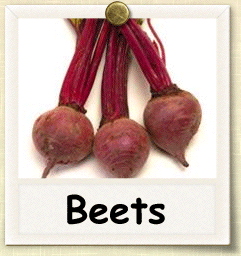|
Seeds > Heirloom > Vegetables > Beet |
|
Heirloom Beets Seed |
|
|
| |
 |
|
Overview |
|
|
|
|
|
| |
|
| |
Easy-to-grow beets do double-duty in the kitchen, producing tasty roots for baking, boiling or sautéing and fresh greens to boil or steam. Plant them early for top quality and best flavor. (Fluctuating weather can reduce quality and create white zone rings in the roots.) Some varieties have red stems and venation in the leaves, making them a natural for edible landscaping. |
|
| |
|
|
| |
Growing Guide
GROWING NOTES
Prefers well-drained sandy loam to silt loam soil, high in organic matter, with pH between 6.5 and 7 and free of large stones. Good soil structure is important because growth is improved by good soil aeration. Beets grow poorly in acid soil. They tolerate low fertility but require consistent moisture. Do not plant in soils with pH less than 6.0.
Beets use boron inefficiently. Boron is less available in soils with high pH and high organic matter. Corky black areas in the roots indicate boron deficiency.
Biennial grown as an annual.
Some varieties have red stems and leaf venation.
MAINTAINING
Plant in early spring, as soon as you can work the soil, ¾ inch deep and 1 inch apart in rows 12 to 18 inches apart. For continuous harvest, make successive plantings every three weeks until midsummer. For winter storage, sow crop about 10 weeks before heavy freeze.
The wrinkled “seedball” usually contains two to four viable seeds, making it necessary to thin to 3- to 4-inch spacings if you plan to harvest young, small or cylindrical-shaped roots, or 6-inch spacings for larger roots for winter storage.
Begin thinning when seedlings are about 4 to 5 inches tall, and eat the thinnings. Cut rather than pull plants when thinning to avoid disturbing roots of other plants.
Some "monogerm" varieties have only one seed per fruit. Some seed companies remove seeds from the seedball.
Unlike most root crops, beets can be started inside or in cold frames and transplanted into the garden.
Use floating row covers to discourage insects early in the season.
Keep well-weeded. Competition and uneven watering can make beets stringy and tough.
Beets are closely related to Swiss chard and spinach. Avoid following these crops in rotation.
Beets tolerate average to low fertility. Too much nitrogen will encourage top growth at the expense of root development.
Best color and flavor develop under cool conditions and bright sun. When beets mature in warm weather, they are lighter colored, have less sugar and have more pronounced color zoning in the roots. Fluctuating weather conditions produce white zone rings in roots.
Beets are biennials. Normally, they produce an enlarged root during their first season. Then after overwintering they produce a flower stalk. If they experience two to three weeks of temperatures below 45 F after they have formed several true leaves during their first season, a flower stalk may grow prematurely. Many newer varieties are less sensitive to this problem.
|
|
| |
|
| |
|
|
| |
|
|
| |
Harvesting Guide
HARVESTING
SAVING SEEDS
|
|
| |
|
|
|
| |
|
|